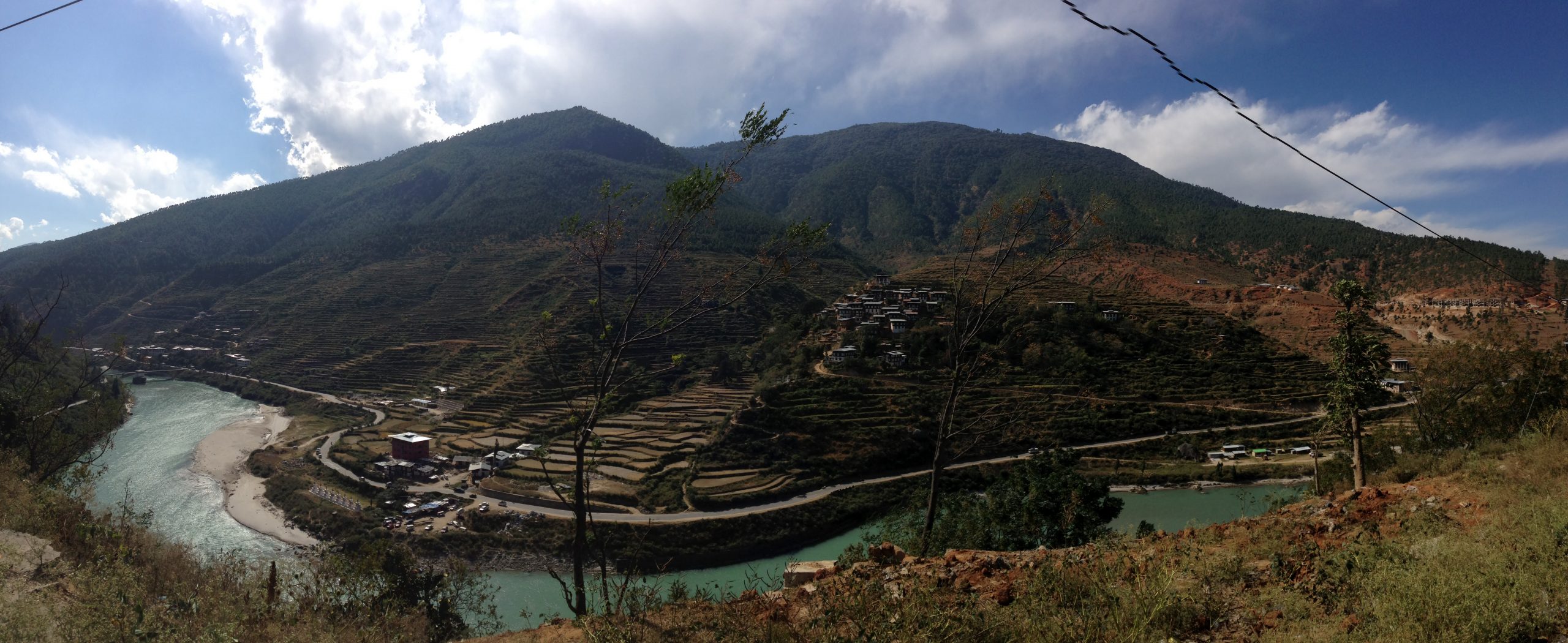67 South Asia: Cultural Geography – Bhutan: Gross National Happiness
“If you want others to be happy, practice compassion. If you want to be happy, practice compassion.”
– Dalai Lama, the highest spiritual leader of Tibet
 Assessment. Rankings. Top Ten lists. Polls, surveys, indices. These are common in the modern world. Gross national product or gross domestic product. GNP and GDP frequently are used as measurements of a country’s success, economically but also as correlated to societal development.
Assessment. Rankings. Top Ten lists. Polls, surveys, indices. These are common in the modern world. Gross national product or gross domestic product. GNP and GDP frequently are used as measurements of a country’s success, economically but also as correlated to societal development.
It certainly is contrasting, and probably refreshing, to find a country that assesses and promotes its citizens’ Gross National Happiness – GNH. This country is Bhutan.
Bhutan is a small mountainous country, parallel to Nepal as both are landlocked between India and China. It is not a rich country, placing 109th among countries of the world in GDP per capita – less than $10,000 per person. Being poor is a barrier to being happy – not a prohibition of happiness, but clearly these characteristics may be correlated.
The unique element of Bhutan is its governmental focus on happiness, to the extent of publicly seeking and assessing Gross National Happiness. Yes, happiness! Importantly, this policy is not one of “ha ha, hee hee!” This is not about standup comedy or dad jokes. It is about well-being. Certainly, well-being can include laughter; however, it also includes satisfaction with life, safety from crime, good health, enough food, good education that leads to better lives, and more. In fact, these are the sorts of things that Bhutan strives to provide for its citizens and instill in its national life.
Of note, the United States has a similar reference. In the American Declaration of Independence, it cites inalienable rights to “Life, Liberty and the pursuit of Happiness.” Americans are entitled to the pursuit of happiness. My political assessment of these rights determines that beyond life and liberty, the pursuit of happiness requires good health and a good education. Surely with bad health, it is difficult to be happy or to pursue happiness. In most cases in the modern world, a good education provides the necessary skills and sometimes the necessary credentials to advance in jobs, careers, and incomes that may correlate with happiness. However, in America there is no governmental policy on happiness, though we hope that government does advance well-being.
How does Bhutan approach the concept of Gross National Happiness? In 1972, the 4th King of Bhutan, King Jigme Singye Wangchuck, stated that gross national happiness is more important that gross domestic product. See the GNH Happiness Index of nine domains and thirty-three indicators at https://www.gnhcentrebhutan.org/what-is-gnh/gnh-happiness-index/
The Bhutanese government surveys its citizens to monitor the progress of GNH. In 2010, 40% of Bhutan’s people had achieved the desired level of happiness.
Let’s consider the government’s four pillars of Gross National Happiness.
1 – sustainable and equitable socio-economic development
While eliminating poverty is a goal, the government also cites the needs of free time and leisure. Three out of five Bhutanese work in agriculture or forestry. Although the mountains work well for hydropower, they inhibit economic and urban development. Long accustomed to bartering, in 2021 Bhutan began taking steps to join the world of cryptocurrency – converting their currency, the Ngultrum, to a digital format.
2 – environmental conservation

As an example of this factor, Bhutan’s constitution requires that at least 60% of the country’s land area be forested. These forests create such a prominent carbon sink that Bhutan has become the world’s only carbon negative country. This means that Bhutan pulls more carbon dioxide out of the air (as with trees “breathing”) than it emits into the atmosphere (typically by human action and pollution).
Legally protected lands include 51% of the country. The Himalayan environment is biodiverse and distinctive. Wildlife roam freely in protected lands. Glacial waters from the Himalaya Mountains provide the flow of Bhutan’s rivers. These rivers typically flow on to India. Bhutan utilizes hydropower from these mountain streams to send considerable flows of electricity to India.
3 – preservation and promotion of culture
Certainly, a major component of Bhutan’s culture is Buddhism. Three out of four Bhutanese practice Vajrayana Buddhism, as is done in the neighboring Tibet region of China. The teachings of Buddhism do place an emphasis on happiness; however, this happiness is not found in material possessions or riches, but in compassion and peace of mind. It seems only natural that a Buddhist country would seek happiness without concern for being financially rich. GNH is seen as part of Buddhism’s “middle path,” seeking happiness through balanced life.

In addition to Buddhist ways, Bhutanese culture includes enjoyment of festivals and the wearing of traditional clothing. In fact, the government requires that people wear traditional attire on special occasions and in government offices. Television broadcasting was illegal in Bhutan until 1999, when the king reversed policies. Thus, Bhutan was one of the last countries in the world to have television. Cable TV became very popular to the happiness of many and the chagrin of some Bhutanese residents.
4 – good governance
In 1999 the government cited efficiency, accessibility, and transparency as essential elements of successful governance. Definitely this would be desired in societies all across the world. While Bhutan appears to be succeeding in these regards, probably a large majority of Americans would assert that its governments work poorly by these standards.
In sum, Bhutan takes a unique approach to government and life, pursuing a Buddhist approach to happiness and contentment that quite contrasts the materialism of much of the modern world.
Did you know?
The World Happiness Report for 2021 excluded Bhutan because the required Gallup polling was not done in Bhutan.
The place name Bhutan means “Land of the Thunder Dragon.”
As it borders India, Bhutan has Hindu believers numbering about ¼ of its population.
My Turn!
CITED AND ADDITIONAL BIBLIOGRAPHY:
GDP per Capita – Worldometer. https://www.worldometers.info/gdp/gdp-per-capita/.
GNH Centre Bhutan – A GNH Organization in Bhutan. https://www.gnhcentrebhutan.org/.
Joanne. Bhutan. photo, 28 Oct. 2012. Flickr, https://www.flickr.com/photos/joannejc/8696675125/. Attribution-NonCommercial-NoDerivs 2.0 Generic (CC BY-NC-ND 2.0)
Kubota, Azusa. “Water and Climate Change | UNDP in Bhutan.” UNDP, 20 March 2020. https://www.bt.undp.org/content/bhutan/en/home/stories/water-and-climate-change.html.
Singer, Adam. Bhutan: Festival. photo, 28 Oct. 2017. Flickr, https://www.flickr.com/photos/77437968@N00/24643115448/. Attribution-NoDerivs 2.0 Generic (CC BY-ND 2.0).

